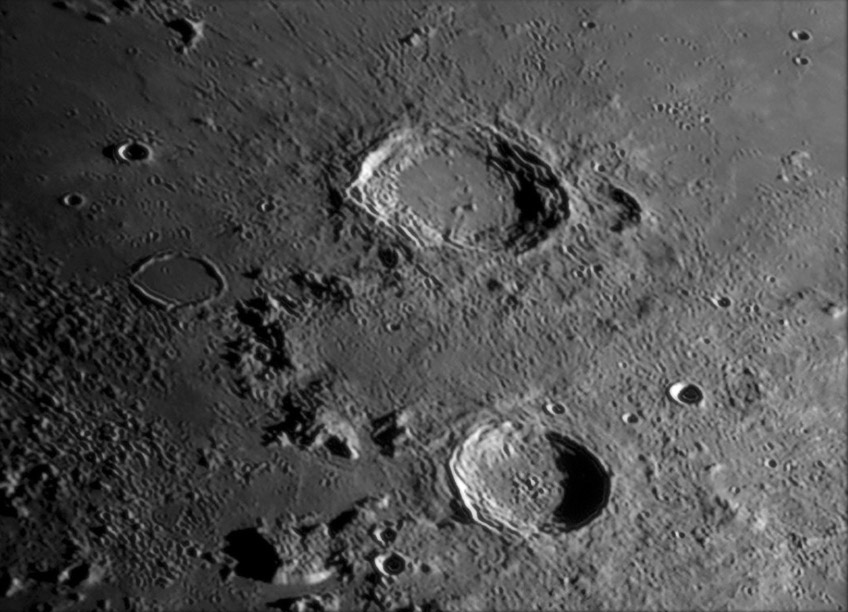June 9, 2008
CEB & DEB

image by Raffaello Lena
When an impact occurs a hemisphere of target rock is excavated and thrown away from the hole. Geologists divide the debris into the continuous ejecta blanket (CEB) and the discontinuous ejecta blanket (DEB). Much material falls back near the crater, forming the CEB, which is where you could walk without ever stepping off the debris. The DEB is further from the crater, being made of isolated ridges of debris, secondary craters and rays. Raff's image reminded me of how different CEBs can be. Aristoteles (the 87 km wide crater at top) is surrounded by a noticeable thickness of ejecta that extends about twice the diameter of the crater. It doesn't feather out for its easy to identify the rounded edge where the CEB topography stops, with crater chains and secondaries extending beyond. Eudoxus is smaller (67 km) and different. Its CEB is a tight wreath around the rim. Instead of having a diameter twice the size (2X) of its crater, it is only about 1.4 times as wide. Why do these differences occur? Does the larger crater, with a more energetic impact, throw CEB material further in some non-linear way? Is there a trend that smaller craters have wreath-like CEBs and larger ones have more extensive ones - or is this just an accident that these craters look this way?
Chuck Wood
Technical Details
Dec 27, 2006, 16:50UT. TMB 13 cm telescope.
Related Links
Rükl plates 5 & 13
Yesterday's LPOD: All Maps Are Good
Tomorrow's LPOD: The Moon is Down - is It Out?
COMMENTS
(1) I'm curious about the strange-looking hills on the lower left side of the image. They all seem to be oriented in the same direction but don't appear to be related to the craters. (??) Are they perhaps part of the Alps, or Caucasus Mountains?
It is a nice coincidence that I was looking at Aristoteles and Eudoxus with my telescope this Sunday evening (6-8-08). With temperatures in the mid-70s F.and clear skies, I was able to spend about two hours observing the Moon. With my Field Map on a small table, I happily went from top to bottom, identifying craters and other features.
We also had clear skies Friday evening. The terminator was on the western edge of Mare Crisium. I spent about an hour focused on the Lavinium and Olivium promontories. As the terminator moved, I'm pretty sure that I saw the "O'Neil's Bridge" illusion flicker into view as the sun rose. (??)
--Bill Murmann
(2) It does make some sense that more energetic impacts would throw up more material. I also wonder if the angle of impact could have some effect as well? If true that both are factors, then the question becomes which factor would be more dominate in the outcome? Of course then there is the material that is being impacted (how loose it is, etc.) that could play a role as well. An interesting problem. -- Andrew Martin SFO
(3) I wonder if these differences in CEBs have been studied by people with access to high-pressure guns (like the ARC http://en.wikipedia.org/wiki/NASA_Ames_Research_Center )? I can imagine the effects of scale would probably prevent extrapolating results up to the several km size craters we see on the lunar surface but I would also think that at least some headway may've been made in this area to understand differences in impact energy / target material / density etc... although I can't find anything myself to shed light on this.
Mark Zambelli
COMMENTS?
Register, Log in, and join in the comments.



